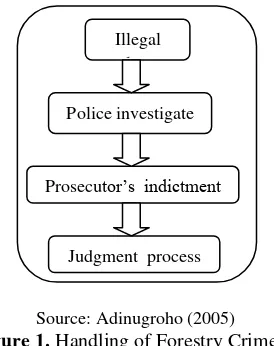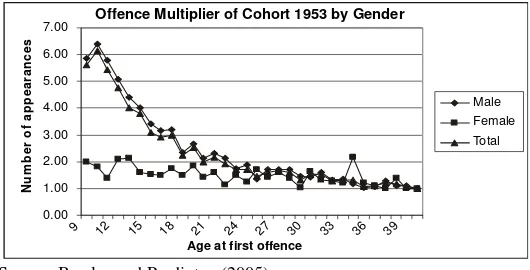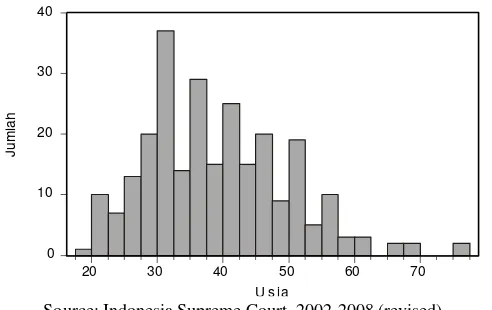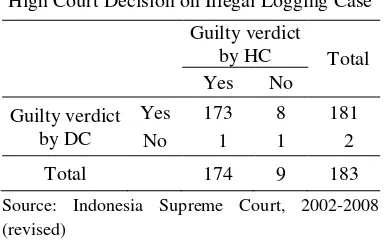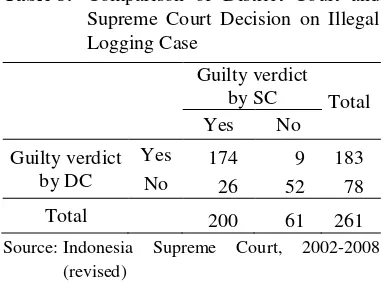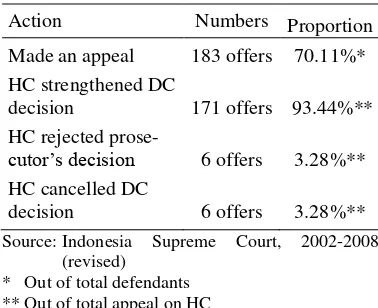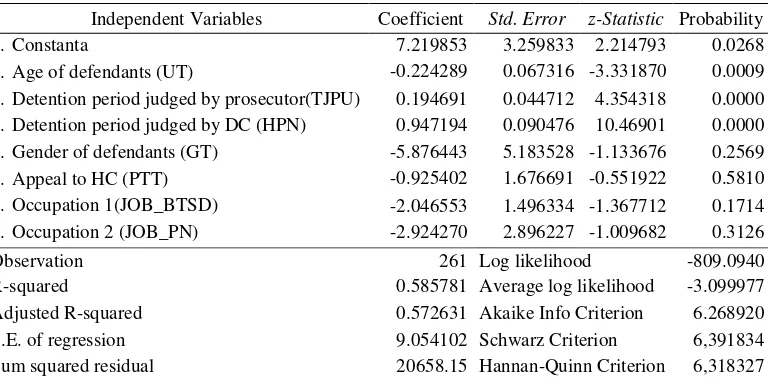Volume 25, Number 3, 2010, 261 – 277
APPLICATION OF RULE OF LAW BY JURISDICTION SYSTEM ON
ILLEGAL LOGGING CASE IN INDONESIA 2002-2008
1Yudistira Hendra Permana2
Universitas Gadjah Mada ([email protected])
ABSTRACT
The aim of this research is to analyze behavior of Supreme Court’s judge on detention period sentence for illegal logging defendants in Indonesia from year 2002through 2008. The first analysis is censored normal regression method using detention period indictment by prosecutor, detention period sentence by district court, defendant’s gender, appeal effort, defendant’s age, and defendant’s job variables. Those variables are used to analyze how each variable affect on Supreme Court’s verdict on detention period sentence for illegal logging defendants in Indonesia. Second analysis is descriptive statistic involves three levels of jurisdiction’s considerations (prosecutor, district court, and Supreme Court) on determining detention period sentence for illegal logging defendants in Indonesia and suitability those three levels of jurisdiction to law. Research’s result shows that detention period indictment by prosecutor, detention period sentence by district court, and defendant’s age significantly affect on Supreme Court’s verdict on detention period sentence for illegal logging defendants in Indonesia. But, on the other hand there is unsuitable verdict made by those three levels of jurisdiction to law.
Keywords: court’s verdict, illegal logging, censored normal regression
INTRODUCTION12
As one of renewable resource, forests have ecological and economical function. Ecologically, forests control species composi-tion’s variation because of its ability to influence ecosystem including food and nutrition supply. While from economic point of view, forest is one of resource of economic commodities. In order to accomplish that function, human intervention is needed, and forest management is required. Some impor-tant things on forest management are harvest cycle of timbers and how to conserve forest in order to fulfill its function, and also including
1
This article has been awarded as the 1st best paper of
JIEB’s Best Paper Awards 2010.
2 I am grateful to Rimawan Pradiptyo for his excellent
guidance.
management of residual wastes from foresting activities.
degra-dation caused by natural factors3 (Lanly, 2003). From the report, decreasing rate of Indonesia’s forest area during 1990-2000 was around 1,872,000 ha/year (-1.7%/year) and 1,871,000 ha/year in 2000-2005 (-2%/year). Totally, around 28,072,000 ha of forest area had been lost during 1990-2005.
In addition to natural factors, forest lost in Indonesia is an outcome of forest exploitation by human activities, such as land clearing for housing area (Barbier, 1993), farm converting (Hasanuddin, 1996; FAO, 1990; and World Bank, 1990), supporting economic growth (Ascher, 1993, Angelsen, 1995, and Dove; 1996), and for country’s politic influence (Ascher, 1993; Dauvergne, 1994; Angelsen, 1995; Rose, 1996; Dove, 1996). Published data by Ministry of Forestry Republic of Indonesia4 shows that deforestation in Indonesia 2000-2005 took place in many regions as listed in Table 1.
Economic development of a country could be one factor causing deforestation. Gillis (1988) and Ahmad (1995) conclude that expansion in wood industry is a trade-off with economic and environment loss. Indonesian government has released law of forestry since Agrarian Act 5/1960 about basic regulations of agrarian by determining right of land, water,
3 Lanly stated that ecosystem may be on unhealthy
condition because of climate change, burning out, and etc.
4
Indonesia forestry statistic 2007.
and air usage in Indonesia. But this law does not explain in detail about rules in forestry sector yet. In 1967, the government released Forestry Act 5/1967 on forestry regulation and continues to amend along the changing of government in Indonesia.
Currently, local government has big authority on management of forestry sector by establishing Forestry Act 41/1999 about forestry. In this case, local government can authorize license for private sector to exploit forest. But, the regulation is still being abused by both private sector and government them-selves. Setiono and Husein (2005) conclude that there is moral hazard practices on license authorization of forest exploitation5. It creates illegal logging activity and may lead to financial loss to the country. Department of Forestry has committed to increase forest security by recruiting new forest ranger and gives special training to them as mandated by Forestry Act 41/1b999 every year. Unfortu-nately, the forest rangers often become dishonest on tackling of illegal logging case by providing security to illegal loggers for self profit (Ama and Santoso, 2005)6.
Many offenders that are brought to the court are only workers, farmers, drivers, and
5 Setiono and Husein (2005) concluded that corruption
activity in forestry may be formed as bribery in license issue and illegal retribution.
6Ama and Santosa (2005) showed case study “Operasi
Hutan Lestari II” and jurisdiction process in Sorong,
Papua.
Table 1. Rate of Deforestation in Indonesia 2000-2005
Year
Deforestation (ha/year)
Sumatra Kalimantan Sulawesi Java Maluku Papua Bali & Nusa
traders. In fact, based on publication by Indonesia Supreme Court, there were 130 offenders during period 2002-2008, and many of them were only employers. Aim of this research is trying to reveal improper practice on tackling of illegal logging that violates the law and attains moral hazard on jurisdiction system. All cases have been published in the official website of the Supreme Court in the
following URL: http://www.putusan.
mahkamahagung.go.id and the study uses 261 defendants data in 2002-2008.
THEORETICAL FRAMEWORK
Crime on Economics Perspective
Study of economic crimes is pioneered by Becker (1968) that conducted research on crime and punishment on economics perspec-tive. Becker (1968) concluded that crime is an economic activity but contradictive with law and can be classified as illegal activity. It makes losses to others so that a method to overcome that illegal activity is needed. Becker (1968) suggested detection and punishment to overcome illegal activity based on offender’s behavior, where offenders interest is on net benefit (expected benefit > expected cost). Then, the theory is developed by Tsebelis (1989), who concluded that punishment level would affect on offender’s tendency to commit crimes with game theory analysis. This theory was also refuted and then Pradiptyo (2007) concluded that crime preven-tion7 would be more effective to reduce offender’s tendency to commit crimes than increasing level of punishment.
Crime and the handling create burdens to society (social cost and economic cost) from economic perspective. Poputra (2009) showed that tax evasion decreases country’s income and injustice. Becker (1968) stated there are two ways to overcome crime, by improving
7 Government intervention to develop society had
potential of crime activity, example preschool program for children.
detection and punishment. But, Becker’s methods create cost guaranteed by government from tax and social cost of offenders for uncompensated potential income (Pradiptyo, 2009). Becker’s method, in which the law enforcer is the most important factor on tackling criminal, is still used in Indonesia. Meliala (Tempo, 2008) argued if the law enforcers have ethics, qualified resource and proper authority, crimes will be reduced and increasing tendency for law enforcement among society. Otherwise, it may increase law violations that lead to chaotic condition in the society. Handoko (2009), on his research, stated that law in criminal justice is a reference for sanctioning those who violates the law with penalties.
Effectiveness of punishment could be serious problem. Bolks and Dina (2000) stated punishment duration is equivalent to cost and expected deterrence effect possible could not be reached8. Pradiptyo (2007) showed that crime mitigation is more effective rather than increasing punishment level, in spite of offender’s probability to do crime decreases by increasing punishment level.
Law Application on Illegal Logging Case
Illegal logging practice in Indonesia was influenced by law and jurisdiction system themselves. There are three regulations on forestry9. First, Forestry Act 5/1967 generally rules about forest ownership by country and classified forest into four forms. After 32 years, government had released forestry law, Forestry Act 41/1999 about government’s authority on forestry and license authorization to private sector to manage forest. This law also regulates forest protection, including conservation and forestry crimes. On 2004,
8 That cost could be negative net-benefit for government
got from social problem when prisoner was in jail. It makes prisoner did not get learning not to repeat criminal activity.
9 Beside those laws, there are enactment rules, like Tap
this law had been revised into Perpu 1/2004 and revised again into Forestry Act 19/2004 due to legal uncertainty on mining in forest area. Law continues to be amended along with government changing, but illegal logging case handling scheme are explained below:
Source: Adinugroho (2005)
Figure 1. Handling of Forestry Crime in
Indonesia
Generally, handling of illegal loggers in Indonesia shows three parts of criminal justice that determine whether offenders were found guilty or not. First is by police investigation where police could arrest and seize timbers if agent cannot show the license (known as SKSHH). Then, police would bring agent to jurisdiction level and get their indictment by prosecutor. This indictment can be reference for court to determine whether defendants were guilty or not. Jurisdiction process could be more than once because there are three levels of jurisdiction system (district court, high court, and Supreme Court) and re-observation process if needed.
METHODOLOGY
Source of Data
I use secondary data of court’s verdict in the year of 2002-2008 published by Indonesia
Supreme Court of illegal logging case10. The data were taken from website in the form of verdict sheet containing information about defendants, detention period judgment, fines, and others. Those data were divided into several variables and then estimated by econometric specification.
Econometric Specification
Model of econometric that was built is Tobin’s probit model (known as Tobit model) that uses maximum likelihood estimation be-cause dependent variable in model, detention period, has no under-null value. General form of Tobit model following as:
y*i = β’Xi + ui 11,
yi = 0 jika y*i ≤ 0,
yi = yi jika y*i > 0.
Tobit model had been assumed has normal distribution of residual and independently identical with zero mean values and common variance σ2 (ui ~ IN(0, σ2). Tobit model was
estimated by maximum likelihood to get consistent β’ and σ’. Maddala (1992) showed that maximum likelihood method used by Tobit model was following these assumptions: 1. Positif values of yi observation is a
standard normal density function. (y*i –
β’Xi)/σ has standard normal distribution
where y*i is dependent variable (estimated
value) and Xi is independent variable
observed values.
2. Null values from observed values of yi in
model is written as y*i = 0 atau β’Xi + ui ≤
0. When ui/σ has standard normal
distribution, the equation for ui/σ can be
expressed as ui/σ ≤ - βXi + ui where ui is
got from y*i – β’Xi.
10
All of data were taken from Indonesia Supreme Court website, http://www.putusan.mahkamahagung.go.id 11 Where y*
i is estimated parameter, yi is observed variable, σ is standard deviation of model, and β’Xi is estimator. Whereas ui is error term of model (yi – y*i). Illegal
log
Police investigate
Prosecutor’s indictment
Density function of f(y*i) that has standard
normal distribution can be classified as:
f((y*i – β’Xi)/σ) for positive value
observa-tion, and
ui ≤ -β’Xi for non-positive value
ob-servation
Cumulative density function of standard normal density f(y*i) are:
P(ui ≤ -βXi) = P(ui/σ ≤ -βXi/σ) (1)
= F(-βXi/σ) (2
Where F(.) is cumulative density function and P(.) is probability of non-positive obser-By maximizing likelihood function to parameter β and σ, we can get maximum likelihood estimation of each parameter that result asymptotic consistent and efficient estimator. Olsen simplified likelihood function on notation (3) to get log-likelihood function
By deriving log-likelihood function into first-order form to parameter B and h, we can get maximum value of parameter and deriving into second-order form to parameter B and h to
get maximum likelihood function12.
Based on general form of Tobit model, model in this research can be written as:
An estimating model used in this research is normal censored regression model. This model assumed that detention period judged by Supreme Court can be estimated and the regression model can be written as:
HMA*i = β0’+ β1’TJPUi + β2’HPNi + associated with various static and dynamic criminogenic factors13. Gender, indictment by prosecutor, judgment by district court, and appeal to high court are considered as static criminogenic factors. Whereas age and occupation are considered as dynamic criminogenic factors.
Explanation of variables used in the model are as follows:
HMA = detention period of defendants (in months). Judged by Supreme Court.
TJPU = detention period of defendants (in
months). Indictment by
prosecutor.
HPN = detention period of defendants (in months). Judged by district court. UT = defendant’s age (in years).
12 See Olsen (1978) for details.
13
Static criminogenic factors are unchangeable infor-mation of individual from time to time, whereas dynamic criminogenic factors are changeable infor-mation of individual from time to time.
If SC made a quilty judgment for defendants
GT = defendant’s gender (dummy
JOB_PN = defendant’s occupation (dum-my variable; 1 if defendant works in public sector, and 0 if others).
JOB_BTSD = defendant’s occupation (dummy variable; 1 if defendant works as worker, farmer, driver, and merchant, and 0 if others).
ANALYSIS
Defendant information
There were 261 defendants of illegal logging in 2002-2008 who were involved in 189 illegal logging cases. Most of them are male who took 98% (256 defendants) whereas female only took 2% (5 defendants).
Table 2. Defendant’s Gender on Illegal
Logging Case 2002-2008
Gender Number
Male 256
Female 5
Total 261
Source: Indonesia Supreme Court, 2002-2008
Bowles and Pradiptyo (2005) found that women have low constant offence multiplier tendency in every single age on beginning starting criminal activity rather than men. On the other side, men have decreasing offence multiplier tendency along with the age on beginning starting criminal activity. It is concluded that the older of man, the more decrease level of criminal activity.
Defendants were occupying different jobs. Many of them were worker, farmer, driver, and merchant who took totally 130 defendants (49.81% of total defendants), then entrepre-neur/private sector who took 112 defendants (42.91% of total defendants). There were also defendants worked in public sector (including police, government employees, and their retiree).
Based on defendant’s age, the youngest was 18 year old who worked as a farmer, and the oldest was 75 years old who worked as an entrepreneur. Mean of defendant’s age was 39 year old and modus of defendants took place on 30-50 year old.
Since 2002 until 2008, Supreme Court had given verdicts on 261 individual illegal logging cases and had volatile trend of number cases. Top number of cases was taking place in the year of 2007 where Supreme Court adjudicated 102 individual illegal logging cases.
Offence Multiplier of Cohort 1953 by Gender
0.00
Table 3. Defendant’s Occupation on Illegal Logging Case 2002-2008
Defendant’s Job Numbers Percentage
Entrepreneur/private sector 112 42,91%
Worker, farmer, driver, and trader 130 49,81%
Public sector 19 7,28%
Total 261 100%
Source: Indonesia Supreme Court, 2002-2008
0 10 20 30 40
20 30 40 50 60 70
U s ia
J
u
m
la
h
Source: Indonesia Supreme Court, 2002-2008 (revised)
Figure 3. Age Distribution of Illegal Logging Defendants
Table 4. Number of Individual Illegal Logging Case Decided by Supreme Court
Year 2002 2003 2004 2005 2006 2007 2008 Total
Number of Defendants 5 4 8 29 81 102 32 261
Source: Indonesia Supreme Court, 2002-2008
In 2007, there were two cases being re-observed. However, Supreme Court had guilty verdict for defendants and consistent with previous punishment. This re-observed decision was asked by defendants if there were supported evidence that can change Supreme Court verdict.
Suitability of Court’s Decision to Law
According to Forestry Act 41/1999 and 19/2004, minimum detention period for illegal logger is three months and maximum of fifteen years. In addition, according to section 78, minimum fine is ten million Rupiahs and maximum fine is five billion Rupiahs. Other
punishments to defendants are financial punishment and probation.
Table 5. Detention Period for Illegal Logging Prisoners in Indonesia13
Level of Jurisdiction Number of
Prisoner Proportion
Mean of Detention
Period
Min. of Detention
Period
Max. of Detention
Period
District Court 182 prisoners 69.7% 12.97 months 1 months 96 months
Supreme Court 200 prisoners 76.6% 16.82 months 1 months 96 months
Prosecutor 261 prisoners 100 % 29.97 months 2 months 144 months
Source: Indonesia Supreme Court, 2002-2008 (revised)
Tabel 6. Test for Equality Between Mean Series of Detention Period Judged by Prosecutor,
district court, and Supreme Court
PairedDifferences t-stat. Prob.
Mean Std. Dev. S.E. of Mean df
1. Prosecutor_sentence-SC_sentence 21.40153 18.80031 0.822867 520 11.69579 0.0000 2. Prosecutor_sentence-DC_sentence 19.51188 18.51729 0.81048 520 15.63513 0.0000
3. DC_sentence-SC_sentence 10.94023 12.1832 0.533244 520 3.583748 0.0004
Source: Indonesia Supreme Court, 2002-2008 (revised)
Again,14district court was level of jurisdiction that had smallest number of guilty verdicts than other level of jurisdiction. District court made guilty judgment to 182 defendants of 261 defendants, or 69 percent of total, whereas prosecutor will always make guilty judgment to all of defendants. But if prosecutor made appeal from district court to Supreme Court, there were possibility of guilty judgment by Supreme Court when district court absolved defendants. It showed by number of guilty defendants on district court and Supreme Court level.
Result of the test in Table 6 shows lower level of jurisdiction charged longer detention period to illegal logging prisoners. All of test result between prosecutor with Supreme Court, prosecutor with district court, and district court with Supreme Court are statistically significant (α=5%). By mean, prosecutor judged detention period twenty one months longer than Supreme Court judgment,
14 Detention period judged by high court could not be
presented because not all of cases were appeal against punishment.
nineteen months longer than district court judgment, and district court judged ten months longer than Supreme Court judgment.
Table 7. Comparison of District Court And
High Court Decision on Illegal Logging Case Guilty verdict
by HC Total
Yes No
Guilty verdict by DC
Yes 173 8 181
No 1 1 2
Total 174 9 183
Source: Indonesia Supreme Court, 2002-2008 (revised)
Statistic resulted from Table 7 shows that there is significant relationship between district court and high court (χ2 = 8.788; df = 1; p = 0.003; with α < 1%)15. This result shows decision consistency between district court and high court, which means little possibilty
for high court to change decision made by district court16.
Table 8. Comparison of District Court and
Source: Indonesia Supreme Court, 2002-2008 (revised)
There is a consistency on decision made by district court and Supreme Court as indicated in Table 7. Statistic test shows that there is significant relationship between dis-trict court and Supreme Court’s decision (χ2
= 116.4343; df=1; p = 0.000; with α<1%)17
. This result shows little probability of Supreme Court to change decision made by district guilty defendats get probation in district court level. Whereas on the first level, prosecutor,
19 When guilty defendants on probation period, they were
not on prison but will be prisoned if guilty defendants do same crime in decided period.
never gives probation but always gives detention. Third form of punishment made by jurisdiction is fines. As explained on Forestry Act 19/ 2004 Section 78 for illegal logging case, minimum fines is ten million Rupiahs and maximum fines is five billion Rupiahs.
Table 9. Probation Sanctioned By Prosecutor,
District Court, and Supreme Court For Indonesia Illegal Logging Case Defendants20
Source: Indonesia Supreme Court, 2002-2008 (revised)
Prosecutor and Supreme Court do not apply Forestry Act 19/2004 for fines punishment. Both of them give minimum fines below the amount ruled by law. On the other side, Supreme Court gives maximum fines as ruled by law, which is not always be done by prosecutor. Total fines collected by Supreme Court was higher than prosecutor in context to guilty defendants judged by Supreme Court (fine ratio is 1:1.145) and it shows that nominal fines will raise along with appeal decision made by defendants or prosecutor.
Other punishment given by court is subsidiary of compensation. As stated on Forestry Act 19/2004 Section 80 sub 1, subsidary of compensation has been used to compensate damage caused by illegal logging case. Nominal compensation depends on the damage itself and regulated by government and ministry of forestry.
20
Table 10. Fines Judgment By Supreme Court And Prosecutor For Indonesia Illegal Logging Defendants20
Level Prisoner (A)
Total Fines (B)
Max. Fines (C)
Min. Fines
(D) B:A B(1) : B(2)
SC (1) 200 Rp. 7,605,325,000 Rp. 5,000,000,000 0 Rp. 38,026,625 1.145
Prosecutor21 (2) 200 Rp. 6,640,250,000 Rp. 500,000,000 0 Rp. 33,201,250 1
Source: Indonesia Supreme Court, 2002-2008 (revised)
Table 11. Nominal of Subsidiary of Compensation For Illegal Logging
Defendants in Indonesia 2002-2008
Level Prisoner Total Compensation
In Rupiah In Dollar
DC - 0 0
SC - 0 0
Prosecutor 2 351,061,627,800 7,144,191.21
Source: Indonesia Supreme Court, 2002-2008 (revised)
Only21 prosecutors22 are able to inflict subsidiary of compensation to their defen-dants, and only two out of 261 defendants that are imposed to the type of punishment (about 0.77% out of total). Whereas district court and Supreme Court have never given that punishment to their defendants. This is an interesting point of concern because forestry act23 has stated that compensation has to be inflicted to guilty defendants for compensating the damages.
There is court of cassation in Indonesia. Appealing to high court may have three possible decisions; strengthen district court decision, reject prosecutor’s accusation, and cancel district court decision to establish its own decision for defendants. However, defendants or prosecutor could make an appeal
21
The table only informs about fine judged by prosecutor and SC. Not all of DC and HC decision are match with SC decision, so fine sentenced by DC, HC, and SC can not be compared. It is different with prosecutor which always made guilty judgment to defendants, so that they can be compared.
22 Only for defendants who had guilty judgment by
prosecutor and SC.
23 Forestry Act 19 Year 2004 Section 80 Sub 1.
through to Supreme Court, by passing high court level.
Table 12. Appeal Process On High Court
Level of Indonesia Illegal Logging Case
Action Numbers Proportion
Made an appeal 183 offers 70.11%*
HC strengthened DC
decision 171 offers 93.44%**
HC rejected
prose-cutor’s decision 6 offers 3.28%**
HC cancelled DC
decision 6 offers 3.28%**
Source: Indonesia Supreme Court, 2002-2008 (revised)
* Out of total defendants ** Out of total appeal on HC
pro-secutor to make an appeal directly through to Supreme Court without firstly propose an appeal to high court.
Highest tendency of high court decision upon appeal was strengthen district court decision (about 93% out of total appeal), and 3.28% for each of high court rejected pro-secutor decision and cancelled district court decision. Rejected prosecutor decision had happened when prosecutor made an appeal over district court decision then high court refined or cancelled the decision. Whereas high court had cancelled district court decision while defendants made an appeal then high court made own decision to defendants.
The interested thing about Indonesia jurisdiction system is defendants or prosecutor can make an appeal directly through to Supreme Court and bypassing high court. It does not follow hierarchial path of jurisdiction level and seems that high court can not show its existency as a formal institution.
Test of Hypotheses
Model that is been built in this paper is
maximum likelihood-censored normal
regression and is used to analyze behavior of court’s decision in Indonesia on illegal logging case. The model is used to obtain information, on whether independent variables are signifi-cant to dependent variable and how indepen-dent variables affect depenindepen-dent variable (positve or negative effect). The result is shown below (Table 13).
Table 13 shows that defendant’s age, prosecutor’s judgment, and district court judgment have effects on Supreme Court decision in order to decide detention period. Supreme Court tends to reduce detention period for older defendants, and the older defendants the lower detention period judged. On the other side, accusation made by prosecutor and judgement by district court could be a reference for Supreme Court decision. Although there were no discrimi-nation on gender and occupation, there is age
Table 13. Estimation Result
Independent Variables Coefficient Std. Error z-Statistic Probability
1.Constanta 7.219853 3.259833 2.214793 0.0268
2.Age of defendants (UT) -0.224289 0.067316 -3.331870 0.0009
3.Detention period judged by prosecutor(TJPU) 0.194691 0.044712 4.354318 0.0000
4.Detention period judged by DC (HPN) 0.947194 0.090476 10.46901 0.0000
5.Gender of defendants (GT) -5.876443 5.183528 -1.133676 0.2569
6.Appeal to HC (PTT) -0.925402 1.676691 -0.551922 0.5810
7.Occupation 1(JOB_BTSD) -2.046553 1.496334 -1.367712 0.1714
8.Occupation 2 (JOB_PN) -2.924270 2.896227 -1.009682 0.3126
Observation 261 Log likelihood -809.0940
R-squared 0.585781 Average log likelihood -3.099977
Adjusted R-squared 0.572631 Akaike Info Criterion 6.268920
S.E. of regression 9.054102 Schwarz Criterion 6,391834
Sum squared residual 20658.15 Hannan-Quinn Criterion 6,318327
Source: Indonesia Supreme Court, 2002-2008 (estimated) Explanation:
a. Dependent variable:
discrimination. In addition, Indonesia juris-diction system does not strictly base its decision to law and justice. As Pradiptyo research (2009) on corruption cases, there is also age discrimination on corruption cases by jurisdiction system.
Revealed fact on this research shows that Indonesia jurisdiction system, especially on handling illegal logging cases, is far from law and regulation. Aim of regulations made in Indonesia is to give detterent effect to offenders. If there were no detterence effect created, offenders or potential offenders will commit to do crime activities as long as the benefit is higher than the cost.
CONCLUSIONS
The findings of this study show that there are deviation on jurisdiction’s decisions. There are two types of deviation, that are descri-mination about age of defendants. The older defendants, the lower detention period they would get. This is indicated in a negative relationship between detention period imposed by Supreme Court and defendants age of illegal logging case. That could be incon-sistency on the regulation (Forestry Act No. 29/2004) and practices in the criminal justice in relation to the court judgement. This is occured on the regulation about minimum detention time, fines, and subsidiary of compensation for the damages caused by the criminal activities, which is very often charged to be less than required by the law.
The regression analysis shows that detention period judged by Supreme Court was influenced by prosecutor and district court judgment for detention period. In addition, court’s decision over forestry case in Indo -nesia have a consistent likelihood so that when the accused is considered to be guilty in the lowest level (district court), little possibilities for higher level changing the decision eventhough prosecutor or defendants proposed an appeal and vice versa.
The implication of this research is to show the evidence of inconsistency on Forestry Act 19/2004 and judgment made by court. Of course that will decrease detterence effect of punishment and potentially increase illegal logging activities. Becker (1968) showed that crime activities would happen if benefit of the activity is higher than cost of activity including punishment that will be gotten.
REFFERENCES
Adinugroho, W. C. 2009. Penebangan Liar (Illegal Logging), Sebuah Bencana Bagi Dunia Kehutanan Indonesia Yang Tak Kunjung Terselesaikan [Illegal Logging, An Unfinished Disaster for Indonesian
Forestry]. Unpublished Theses,
Undergraduate Program. Bogor: Institut Pertanian Bogor.
Ahmad, M. 1995. The Role of Timber Pro-duction in Indonesian Economy: Reality or Illusion?. Konphalindo, Jakarta. Angelsen, A. 1995. Shifting Cultivation and
Deforestation: A Study From Indonesia. World Development,23 (10), 1713-1729. Ascher, W. 1993. Political Economy and Problematic Forestry Policies in Indo-nesia: Obstacles to Incorporating Sound Economics and Science. The Center for Tropical Conservation, Duke University. July.
Badan Perencanaan dan Pembangunan
Nasional [National Planning and
Development Agency], 2008.
Pembalakan Liar Rugikan Negara [Illegal Logging Harms the Nation]. Available at http://els.bappenas.go.id/upload/kliping/P embalakan%20Liar.pdf, accessed Januari 20, 2010.
Becker, Gary S. 1968. Crime and Punishment: An Economic Approach. Columbia University.
Bolks, Sean M. and Al-Sowayel, Dina (2000). How Long Do Economic Sanction Last? Examining the Sanction Process through Duration. Sage Publication, Vol. 53, No. 2.
Bowles, R. and Rimawan Pradiptyo. 2005. Young Adults in the Criminal Justice System: Cost and Benefit Considerations. Centre for Criminal Justice Economics and Psychology. University of York, UK. Dauvergne, P. 1994. The Politics of Defore-station in Indonesia. Pacific Affairs 66 (4), 497-518.
Departemen Kehutanan Indonesia. 2008. Statistik Kehutanan Indonesia 2007 [Indonesian Forestry Statistic 2007].
Departemen Kehutanan Indonesia.
Indonesia.
Dove, M. R. 1996. So Far From Power, So Near to the Forest: A Structural Analysis of Gain and Blame in Tropical Forest Development. In C. Padoch and N.L. Peluso (eds), Borneo in Transition: People, Forests, Conservation, and Development. Oxford University Press, 41-58. Kuala Lumpur.
FAO. 1990. Situation and Outlook of the Forestry Sector in Indonesia. Volume 1: Issues, Findings and Opportunities. Ministry of Forestry, Government of Indonesia; Food and Agriculture Organi-zation of the United Nations, Jakarta. Food and Agriculture Organization of the
United Nations, 2005. Tropical
Deforestation Table. Available at http:// rainforests.mongabay.com/deforestation_ alpha.html, accessed November 4, 2009. Food and Agriculture Organization of the
United Nations, 2003. Country Forest Data, The State of the World’s Forests
2003. Available at http://www.
mongabay.com/deforestation.htm, accessed November 4, 2009.
Ghuzini, D. and Rimawan Pradiptyo. 2009. Carbon Trade dan Pembalakan Liar di Indonesia Berdasarkan Putusan MA: 2002-2008 [Carbon Trade and Illegal Logging in Indonesia Based on Supreme Court Justification: 2002-2008]. Univer-sitas Gadjah Mada, Indonesia.
Gillis, M. 1988. The Logging Industry in Tropical Asia. Dalam J.S. Denslow and C. Padoch (eds), People of the Tropical Rainforest. University of California Press, 177-184. Berkeley.
Goldfeld, Stephen M., Richard E. Quandt, and Hale F. Trotter. 1966. Maximization by Quadratic Hill-Climbing. Econometrica, Volume 34, 541-551.
Greene, W. H. 2000. Econometric Analysis: Fourth Edition. Prentice Hall Press: New Jersey.
Gujarati, Damodar N. 2003. Basic Econo-metric: Fourth Edition. McGraw-Hill Press: Singapore.
Handoko, R. 2009. Kebijakan Hukum Pidana Dalam Penanggulangan Tindak Pidana Narkotika dan Psikotropika. Unpublished Theses, Undergraduate Program. ta: Universitas Muhammadiyah Surakar-ta.
Hasanuddin, L. 1996. Mitos-Mitos Pengelo-laan Hutan di Indonesia [The Myth of Forest Management in Indonesia]. Waha-na Lingkungan Hidup (Walhi) Indonesia / Friends of the Earth Indonesia.
Indonesia Corruption Watch, 2005. Hukum Mandul, Hutan Pun Gundul [When The Law is Barren, The Forest is Shaven].
Available at
http://antikorupsi.org/indo/content/view/4 238/6/, accessed Januari 20, 2010. Jurajda, Stepan. 2003. Econometrics of Panel
Data and Limited Dependent Variable Models: Lecture Note Series. CERGE-EI. Charles University.
Kitab Undang-Undang Hukum Pidana
Criminal Act Law of Republic of Indonesia].
Lanly, Jean Paul. 2003. Deforestation and Forest Degradation Factors. XII World Forestry Congress. Quebec, Canada. Lens, Vicki. 2003. Reading Beetween the
Lines: Analyzing the Supreme Court’s View on Gender Discrimination in Employment, 1971-1982. The Social Service Review, Volume 77, No. 1, 25-50 University of Chicago Press: Chicago. Maddala, G. S. 1992. Introduction to
Econo-metric: Second Edition. Macmillan Publishing Company: New York.
Mahkamah Agung [Supreme Court], 2009. Daftar Putusan Mahkamah Agung Pidana Khusus Lingkungan [List of Decisions of Criminal Supreme Court Particular In Environment]. Available at http:// putusan.mahkamahagung.go.id/appmari/p utusan/index.php?cgyid=20b9031c89f69 9d59202fe933a3a58af, accessed April 11, 2009.
McDonald, John F., and Robert A. Moffitt. 1980. The Uses of Tobit Analysis. Econometrica, Volume 62 (2), 318-321. Olsen, Randall J. 1978. Note On the
Uniqueness of the Maximum Likelihood Estimation for the Tobit Model. Econometrica, Volume 46, 1211-1215. Palmer, C. E. 2000. ‘The Extent and Causes of
Illegal Logging: An Analysis of Major Cause of Tropical Deforestation in Indonesia’. CSERGE Working Paper. University College London.
Peraturan Pemerintah Pengganti Undang-Undang Republik Indonesia No. 1 Tahun 2004 Tentang Perubahan Atas Undang-Undang No. 41 Tahun 1999 Tentang Kehutanan [Government Regulations in Exchange for Laws of Republic of Indonesia No. 1 Year 2004 Concerning The Change of Laws No. 41 Year 1999 over Forestry].
Poputra, A. T. 2009. Ketataatan Pajak Peng-hasilan di Indonesia [Income Tax
Conformation in Indonesia]. Unpublished Dissertation, Post-Graduate Program, Universitas Gadjah Mada, Indonesia. Pradiptyo, R. 2009. A Certain Uncertainty; An
Assessment of Court Decision in Tackling Corruption in Indonesia 2001-2008. Universitas Gadjah Mada, Indonesia. Pradiptyo, R. 2007. Does Punishment Matter?
A Refinement of the Inspection Game. Centre for Criminal Justice of Economics and Psychology. University of York, UK. Rattner, Arye. 1988. Convicted but Innocent:
Wrongful Conviction and the Criminal Justice System. Law and Human Behavior Journal, Volume 12, No. 3. Ross, M. 1996. Conditionality and Logging
Reform in the Tropics. InR. O. Keohane and M. A. Levy (eds), Institutions for Environmental Aid: Problems and Prospects. MIT Press, 167-197. Cambridge, Massachusetts.
Setiono, Bambang., dan Yunus Husein. 2005.’Memerangi Kejahatan Kehutanan dan Mendorong Prinsip Kehati-hatian
Perbankan Untuk Mewujudkan
Pengelolaan Hutan Yang Berkelanjutan: Pendekatan Anti Pencucian Uang’ [Fight Forestry Crime and Support The Principle for Sustainable Forest Management: Anti Money Laundering Approach]. CIFOR Occasional Paper, No. 44(i).
Sunderlin, W. D. dan Ida Aju Pradnja Resosudarmo. 1997. ‘Laju dan Penyebab Deforestasi di Indonesia: Penelaahan Kerancuan dan Penyelesaiannya’ [Cause of Deforestation in Indonesia: Study of Reservation and Solutions]. CIFOR Occasional Paper, No. 9(I). Indonesia. Tietenberg, Tom. 1996. Environmental and
Natural Resource Economics: Fourth Edition. Harper-Collins College Publishers.
Tsebelis, G. 2007. The Abuse of Probability in Political Analysis. In R. Pradiptyo (eds), Does Punishment Matter? A Refinement of the Inspection Game. Centre for Criminal Justice of Economics and Psychology. University of York, UK. Undang-Undang Republik Indonesia No. 5
Tahun 1960 Tentang Peraturan Dasar Pokok-Pokok Agraria [Laws of Republic of Indonesia No. 5 Year 1960 Concerning Principal Fundamental Rules of Agrarian Affairs].
Undang-Undang Republik Indonesia No. 5
Tahun 1967 Tentang
Ketentuan-Ketentuan Pokok Kehutanan [Laws of Republic of Indonesia No. 5 Year 1967 Concerning Principal Clause of Forestry]. Undang-Undang Republik Indonesia No. 41
Tahun 1999 Tentang Kehutanan [Laws of Republic of Indonesia No. 41 Year 1999 Concerning Forestry].
Undang-Undang Republik Indonesia No. 19
Tahun 2004 Tentang Penetapan
Pemerintah Pengganti UURI No. 41 Tahun 1999 Tentang Kehutanan [Laws of
Republic of Indonesia No. 19 Year 2004 Concerning Government Establishment in Exchange of Laws of Republic of Indonesia No. 41 Year 1999 Concerning Forestry].
Undang-Undang Republik Indonesia No. 15 Tahun 2002 Tentang Tindak Pidana Pencucian Uang [Laws of Republic of Indonesia No. 15 Year 2002 Concerning Criminal Act of Money Laundering]
.
UNFCC. 2009. Copenhagen Accord: Draft Decision by 15th COP Meeting. 15th COP Meeting. Copenhagen, Denmark.
Uni Sosial Demokrat [Social Demokrat
Organization], 2008. Prediksi
Kriminalitas 2008 [Criminality Prediction
2008]. Available at http://
www.unisosdem.org/article_detail.php?ai d=9407&coid=1&caid=34&gid=2, accessed Januari 20, 2010.
APPENDICES
I. Censored Normal Regression Estimation
Dependent Variable: TMA
Method: ML - Censored Normal (TOBIT) (Quadratic hill climbing) Date: 02/23/10 Time: 02:22
Sample: 1 261
Included observations: 261 Left censoring (value) at zero
Convergence achieved after 5 iterations
Covariance matrix computed using second derivatives
Coefficient Std. Error z-Statistic Prob.
TPN 0.947194 0.090476 10.46901 0.0000
UT -0.224289 0.067316 -3.331870 0.0009
TJP 0.194691 0.044712 4.354318 0.0000
PTT -0.925402 1.676691 -0.551922 0.5810
JOB_PN -2.924270 2.896227 -1.009682 0.3126
GT -5.876443 5.183528 -1.133676 0.2569
JOB_BTSD -2.046553 1.496334 -1.367712 0.1714
C 7.219853 3.259833 2.214793 0.0268
Error Distribution
SCALE:C(9) 10.98022 0.573213 19.15555 0.0000
R-squared 0.585781 Mean dependent var 12.82989
Adjusted R-squared 0.572631 S.D. dependent var 13.84981
S.E. of regression 9.054102 Akaike info criterion 6.268920
Sum squared resid 20658.15 Schwarz criterion 6.391834
Log likelihood -809.0940 Hannan-Quinn criter. 6.318327
Avg. log likelihood -3.099977
Left censored obs 62 Right censored obs 0
Uncensored obs 199 Total obs 261
II. Residual Graph of Estimation
-30 -20 -10 0 10 20 30 40 50
50 100 150 200 250
III. Statistic Sample
Mean N S.D.
Detention period judged by prosecutor 29.97318 261 19.20765
Detention period judged by DC 9.050575 261 9.921956
Detention period judged by SC 12.82989 261 13.84981
IV. Classification Table for Guilty Judgment 1
Guilty judgment by HC
Total
Yes No
Guilty judgment by DC Yes 173 8 181
No 1 1 2
Total 174 9 183
Chi-Square Test
Statistic test df Value Prob.
Pearson Chi-Square 1 8.788579 0.003
Likelihood Ratio 1 3.452088 0.0632
V. Classification Table for Guilty Judgment 2
Guilty judgment by SC
Total
Yes No
Guilty judgment by DC Yes 174 9 183
No 26 52 78
Total 200 61 261
Chi-Square Test
Statistic test df Value Prob.
Pearson Chi-Square 1 116.4343 0.000

